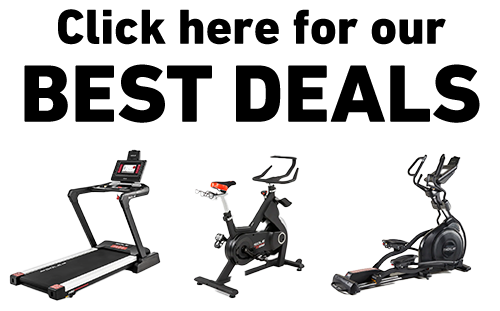Key Takeaways
- 15,000 steps converts to approximately 6.8–7.5 miles for the average adult, though this varies based on individual stride length.
- Your height significantly impacts conversion rates; taller individuals cover more distance with the same number of steps.
- Walking pace affects your step-to-mile ratio, with faster paces resulting in longer strides and more distance covered.
- Using a simple formula (steps × stride length in feet ÷ 5,280), you can calculate your personalized steps-to-miles conversion.
- SOLE treadmills provide precise distance tracking and pace control, eliminating guesswork in step-to-mile conversions while offering superior joint protection through Cushion Flex technology.
Understanding Why 15,000 Steps is an Achievement
Wondering exactly how far you've walked after hitting that impressive 15,000 step count on your fitness tracker? You're not alone. While most fitness enthusiasts focus on step goals, understanding the actual distance covered provides a clearer picture of your exercise achievements.
The conversion from steps to miles isn't one-size-fits-all. Those 15,000 steps translate to between 6.8 and 7.5 miles for most adults, but several factors influence your personal conversion rate.
Your height, stride length, walking pace, and even the terrain you're traversing all play crucial roles in determining how far you've actually traveled.
|
Award-Winning Commercial-Grade Treadmills for Your Home
Why Choose SOLE: ✓ Commercial-grade steel frames with up to 4.0 HP motors 30-Day Money-Back Guarantee: Love it or return it, no questions asked. |
How Far is 15,000 Steps for Most Adults?

The standard conversion range accounts for common stride lengths across the adult population, but individual variations can significantly impact your personal distance calculations.
Quick Steps-to-Miles Conversion Chart
|
Steps |
Average Distance (Miles) |
Shorter Stride (5'4" person) |
Longer Stride (5'9" person) |
|
1,000 |
0.5 |
0.45 |
0.55 |
|
5,000 |
2.5 |
2.25 |
2.75 |
|
10,000 |
5.0 |
4.5 |
5.5 |
|
15,000 |
7.5 |
6.75 |
8.25 |
|
20,000 |
10.0 |
9.0 |
11.0 |
Standard Conversion Rates by Height
Your height is one of the most reliable predictors of stride length, which directly impacts your steps-to-miles conversion. Taller individuals naturally take longer strides, covering more ground with each step.
For example, someone who is 6'0" tall might cover a mile in just 2,000 steps, while someone who is 5'2" might need closer to 2,400 steps to walk the same distance.
For a 15,000-step count, this height difference creates significant variation in distance covered. The 6'0" individual might walk about 7.5 miles, while the 5'2" person might cover closer to 6.25 miles with the same step count.
How Pace Affects Your Distance
Walking pace affects your step-to-mile ratio. When you walk faster, your stride naturally lengthens, meaning you cover more ground with each step.
At a leisurely pace of 2 mph, an average adult might take about 2,500 steps per mile. Increase that to a brisk 4 mph walk, and the same person might take only 2,000 steps to cover the same distance.
Why 15,000 Steps Might Not Equal the Same Miles for Everyone

Beyond height and pace, factors like terrain, fitness level, and individual walking mechanics create unique step-to-mile ratios for each person.
Beyond height and pace, numerous other factors can influence your personal steps-to-miles conversion. Terrain plays a significant role; walking uphill typically requires shorter strides than walking on flat ground, while downhill walking often leads to longer strides. Walking on uneven surfaces like trails or sand forces your body to adapt with varying stride lengths.
Even your fitness level matters; those with stronger leg muscles and better flexibility often maintain longer strides throughout their walks. Weight distribution and walking mechanics also factor into your step length. Some people naturally walk with a wider gait or have a distinctive heel-to-toe pattern that affects how much ground they cover with each step.
Calculate Your Personal Step-to-Mile Ratio
To get the most accurate conversion from steps to miles, you'll need to determine your personal stride length. This personalized approach is far more reliable than using population averages and will help you track your fitness progress with greater precision.
How to Measure Your Stride Length
Measuring your stride length is surprisingly simple and only takes a few minutes. Find a track or area where you know the exact distance, such as a 100-foot stretch or a quarter-mile track.
Walk naturally across this distance while counting your steps. For the most accurate results, repeat this test 3–4 times and take the average.
Divide the total distance (in feet) by the number of steps taken to find your average stride length in feet. For example, if you walk 50 feet in 24 steps, your stride length would be approximately 2.08 feet (50 ÷ 24 = 2.08).
The Simple Math Formula That Works Every Time
Once you know your stride length, converting steps to miles becomes straightforward. The formula is: (Number of steps × stride length in feet) ÷ 5,280 = miles walked.
For someone with a 2.2-foot stride who walks 15,000 steps, the calculation would be: (15,000 × 2.2) ÷ 5,280 = 6.25 miles.
Using Tools That Do the Math For You
Most modern fitness trackers and smartwatches allow you to input your height, weight, and sometimes even your measured stride length to provide more accurate distance estimates.
Some advanced devices can automatically detect changes in your walking pattern and adjust calculations accordingly, accounting for different terrains and walking speeds throughout your day.
How Walking Pace Changes Your Results

As walking speed increases, stride length naturally extends, creating significant differences in distance covered for the same number of steps.
Walking pace influences your step-to-mile conversion, often more than people realize. As your speed increases, your stride naturally lengthens, meaning you cover more ground with each step.
This relationship isn't linear; doubling your pace doesn't simply double your stride length, but it does significantly increase the distance covered per step.
Slow Walking (2 mph): Distance and Benefits
At a slow walking pace of around 2 mph, the speed you might maintain while window shopping or taking a relaxed stroll, your stride length typically shortens.
For someone of average height, 15,000 steps at this pace might translate to approximately 6–6.5 miles, rather than the standard 7–7.5 miles at a moderate pace.
Slow walking has distinct health benefits, particularly for beginners, older adults, or those recovering from injury. It puts less stress on joints while still improving cardiovascular health, and it's excellent for mental well-being and stress reduction.
Average Walking (3 mph): Distance and Benefits
At an average walking pace of 3 mph, the typical speed of someone walking with purpose but not rushing, 15,000 steps generally converts to about 7–7.5 miles for a person of average height.
This moderate pace represents the standard most health guidelines refer to when making step recommendations.
Walking at this pace burns approximately 300–400 calories per hour for most adults, which makes those 15,000 steps equivalent to roughly 700–900 calories burned.
Running vs. Walking: Steps-to-Miles Differences
The steps-to-miles conversion changes when you switch from walking to running. When running, your stride naturally lengthens as both feet leave the ground simultaneously during each step cycle.
The average runner takes approximately 1,400–1,700 steps per mile, compared to the 2,000–2,500 steps walkers take to cover the same distance.
This means 15,000 running steps could translate to 8.8–10.7 miles, a significant increase over walking.
Eliminate Guesswork with SOLE's Precise Distance Tracking

SOLE treadmills transform step counting from guesswork into precision fitness tracking, providing exact distance measurements while protecting your joints through advanced cushioning technology.
Tired of wondering how far you've actually walked when you hit 15,000 steps? SOLE treadmills remove all uncertainty by providing exact distance measurements and consistent pace control that outdoor walking simply can't match.
The F80 Treadmill delivers precise speed settings from 0.5–12 mph, letting you maintain exact paces that develop your natural stride patterns while tracking every tenth of a mile accurately.
What makes SOLE perfect for serious step counters is the Cushion Flex Whisper Deck technology that reduces impact by 40%.
This joint protection allows you to maintain consistent stride patterns throughout longer sessions without the fatigue and form breakdown that occurs on hard outdoor surfaces. The result? More accurate step-to-mile ratios and the ability to train at higher volumes safely.
The F85 and F89 models take precision further with advanced programming that includes interval training to develop different stride lengths at various paces.
No matter if you're training for that perfect 15,000-step daily goal or building up gradually from lower step counts, SOLE's commercial-grade motors maintain exact speeds that help you understand your true walking patterns.
The lifetime warranty on frame and motor shows SOLE's confidence in their precision engineering. Plus, the free SOLE+ App includes distance-based workouts that complement your step goals with structured training programs.
Ready to know exactly how far those 15,000 steps take you? Shop the SOLE treadmill collection today!
Frequently Asked Questions (FAQs)
How long does it take to walk 15,000 steps?
For the average person walking at a moderate pace of 3 mph, completing 15,000 steps takes approximately 2.5 hours of dedicated walking time. This doesn't need to happen all at once; many people accumulate these steps throughout their day through intentional exercise walks and regular daily activities. At 4 mph, you could complete 15,000 steps in closer to 1.75–2 hours.
Is walking 15,000 steps daily too much for beginners?
For most beginners, jumping directly to 15,000 steps daily is too aggressive and could lead to burnout or injury. A more sustainable approach is to start with your current average step count and increase by 500–1,000 steps per week. Most fitness experts recommend building up to higher step counts over 1–3 months, depending on your starting fitness level.
How many calories do you burn walking 15,000 steps?
A 150-pound person burns approximately 600–675 calories for 15,000 steps when walking at a moderate pace on level ground. A 200-pound person would burn closer to 800–900 calories for the same activity, while someone weighing 120 pounds might burn 480–540 calories. Walking uphill or at faster paces can increase these numbers by 20–30%.
Do 15,000 steps count as an active day?
Accumulating 15,000 steps definitely qualifies as an active day for most individuals. Health organizations typically classify daily step counts above 10,000 as "active," with 15,000+ steps falling into the "very active" category.
How do SOLE treadmills improve step-to-mile accuracy compared to outdoor walking?
SOLE treadmills eliminate the guesswork in step-to-mile conversions by providing precise distance measurements and consistent pace control. Unlike outdoor walking, where terrain, weather, and pace variations affect your stride length, SOLE's F80 and F85 models maintain exact speeds and track distance accurately to the tenth of a mile. The Cushion Flex Whisper Deck technology reduces impact by 40%, allowing you to maintain consistent stride patterns throughout longer sessions.




Leave a comment
This site is protected by hCaptcha and the hCaptcha Privacy Policy and Terms of Service apply.